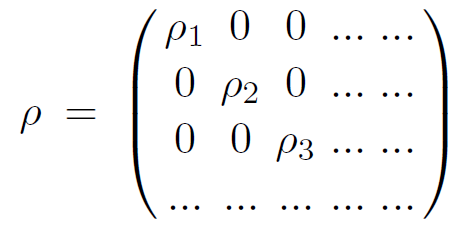
Review of the Density Matrix
 المؤلف:
Leonard Susskind And James Lindesay
المؤلف:
Leonard Susskind And James Lindesay
 المصدر:
AN INTRODUCTION TO BLACK HOLES, INFORMATION, AND THE STRING THEORY REVOLUTION
المصدر:
AN INTRODUCTION TO BLACK HOLES, INFORMATION, AND THE STRING THEORY REVOLUTION
 الجزء والصفحة:
الجزء والصفحة:
 14-12-2015
14-12-2015
 2059
2059
Review of the Density Matrix
Suppose a system consists of two subsystems, A and B, which have previously been in contact but are no longer interacting. The combined system has a wavefunction
Ψ = Ψ(α, β) (1.1)
where α and β are appropriate commuting variables for the subsystems A and B.
Now suppose we are only interested in subsystem A.A complete description of all measurements of A is provided by the density matrix ρA(α, α' ).
 (1.2)
(1.2)
Similarly, experiments performed on B are described by ρB(β, β' ).
 (1.3)
(1.3)
The rule for computing an expectation value of an operator a composed of A degrees of freedom is
 (1.4)
(1.4)
Density matrices have the following properties:
1) Tr ρ = 1 (total probability=1)
2) ρ = ρ† (hermiticity)
3) ρj ≥ 0 (all eigenvalues are positive or zero)
In the representation in which ρ is diagonal
 (1.5)
(1.5)
The eigenvalues ρj can be considered to be probabilities that the system is in the jth state. However, unlike the case of a coherent superposition of states, the relative phases between the states | j› are random.
There is one special case when the density matrix is indistinguishable from a pure state. This is the case in which only one eigenvalue ρj is nonzero. This case can only result from an uncorrelated product wave function of the form
 (1.6)
(1.6)
A quantitative measure of the departure from a pure state is provided by the Von Neumann entropy
 (1.7)
(1.7)
S is zero if and only if all the eigenvalues but one are zero. The one non-vanishing eigenvalue is equal to 1 by virtue of the trace condition on ρ. The entropy is also a measure of the degree of entanglement between A and B. It is therefore called the entropy of entanglement.
The opposite extreme to a pure state is a completely incoherent density matrix in which all the eigenvalues are equal to 1/N, where N is the dimensionality of the Hilbert space. In that case S takes its maximum value
 (1.8)
(1.8)
More generally, if ρ is a projection operator onto a subspace of dimension n, we find
S = log n (1.9)
Thus we see that the Von Neumann entropy is a measure of the number of states which have an appreciable probability in the statistical ensemble. We may think of eS as an effective dimensionality of the subspace described
by ρ.
The Von Neumann (or entanglement) entropy should not be confused with the thermal entropy of the second law of thermodynamics. This entropy has its origin in coarse graining. If a system with Hamiltonian H is in thermal equilibrium at temperature T = 1/β then it is described by a Maxwell–Boltzman density matrix
 (1.10)
(1.10)
In this case the thermal entropy is given by
 (1.11)
(1.11)
 الاكثر قراءة في الثقوب السوداء
الاكثر قراءة في الثقوب السوداء
 اخر الاخبار
اخر الاخبار
اخبار العتبة العباسية المقدسة


